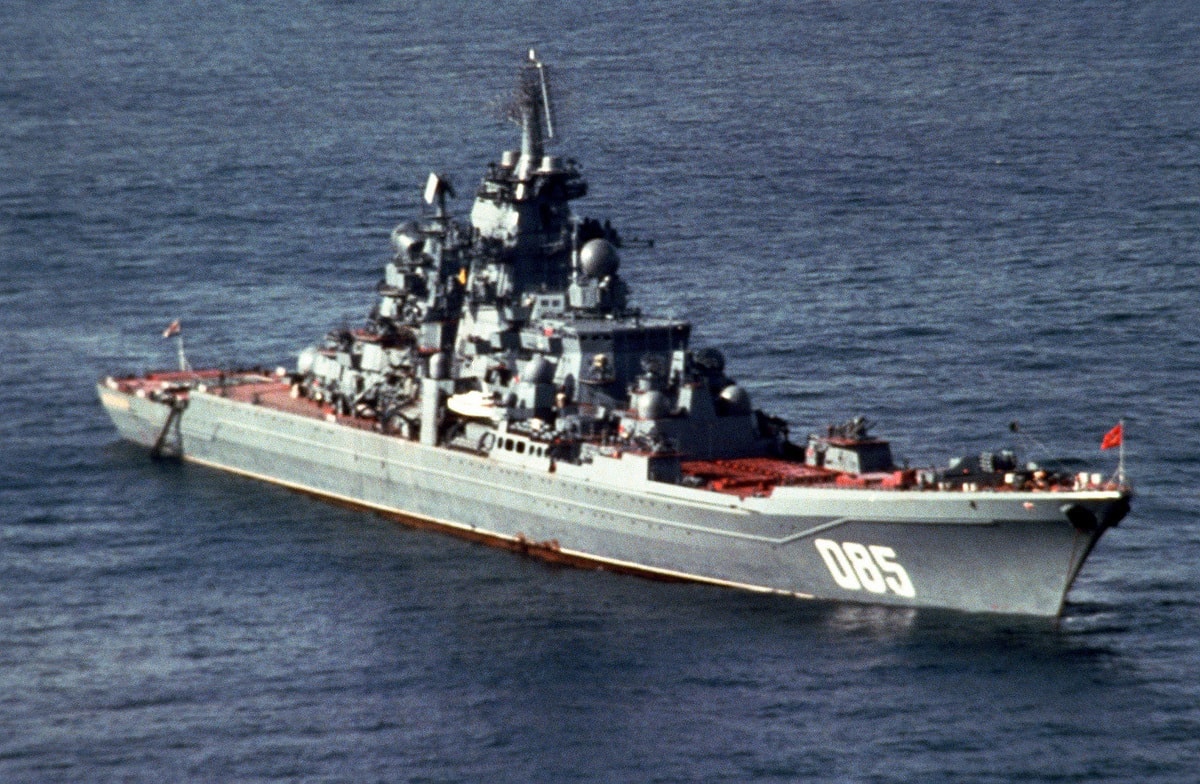Ok, so we all know the age of the battleships is clearly over, as there are no such ships sailing anymore. However, Russia does have several nuclear-powered battlecruisers that are nearly as big and likely way more powerful. Here is how one Russian military expert details their capabilities: As Russia’s only remaining battlecruisers still in service, Russia’s Kirov-class warships likely have a significant service life ahead of them. These two remaining examples, the Pyotr Velikiy and Admiral Nakhimov are the largest armed ships in Russian service and in the world today, apart from aircraft carriers.
However, issues with the modernization and refit of both have shrouded the future of the class in doubt.
Origins of the Kirov-Class
The first ship of the Kirov class was first laid down in 1974, while the Pyotr Velikiy and Admiral Nakhimov (the only surviving examples of the class) were laid down in 1983 and 1986 respectively.
Having been designed in the twilight years of the Cold War, where the Soviet Navy expected to go toe-to-toe with American carrier groups, the Kirov class ships found themselves somewhat out of place after the collapse of the Soviet Union, which left its Russian successor few resources to devote to a large navy with nuclear-powered missile cruisers such as the Kirovs.
Kirov-Class – A Troubled Post-Soviet History
In the decades after the Soviet Union’s collapse, Russian naval leadership hemmed and hawed over competing plans to scrap or refit the other two ships of the Kirov class: the Admiral Ushakov and Admiral Lazarev. Despite some previous indications that the two would be refitted, Moscow evidently decided that they would be too burdensome to maintain, as the Russian Navy announced in 2019 that it planned to cancel the modernization and service-life extensions of both vessels and begin scrapping them in 2021.
Russia’s only remaining operational Kirov is the Pyotr Velikiy, which is the flagship of the Russian Northern Fleet. Despite its age, the Pyotr Velikiy (which is named after Peter the Great), is an active participant in Russian naval exercises. As recently as March, the Pyotr Velikiy took part in exercises off in the Norwegian Sea that practiced the use of surface-to-air missiles and shadowed NATO’s Cold Response exercises.
More infamously, Pyotr Velikiy was the flagship of an exercise in 2000 in which the Russian nuclear submarine Kursk was accidentally sunk.
Present and Future Capabilities
Both ships are massive in scale, which is in a large part a function of their correspondingly large missile arsenals. In terms of air-to-air armament, Kirov-class cruisers can carry 96 S-300F, 40 4K33, and 192 3K95 short-range surface-to-air missiles, as well as six AK-630 close-up defense systems. However, the principal armament of a Kirov is its arsenal of 20 P-700 Granit anti-ship missiles, each of which weighs in at more than 15,000 pounds.
The future of the Kirov class can be seen in the ongoing refit of the Admiral Nakhimov, a process which has been ongoing since 1997. While significant attention in Admiral Nakhimov’s refit is being given to the planned addition of modern Kalibr and Oniks anti-ship missiles and Otvet anti-submarine missiles to the ship, the ship’s outdated enriched-uranium nuclear reactors have proven to be difficult to work with.
There is some information to suggest the Admiral Nakhimov (and the Pyotr Velikiy, if/when it begins its refit) will be equipped with Russia’s new hypersonic Tsirkon missiles, which are currently under development. Even though it is possible that the Pyotr Velikiy would immediately begin refit once the process is completed on the Admiral Nakhimov, the fact that what was supposed to be a process of a few years has seen the estimated completion date of the Admiral Nakhimov’s refit be pushed back to 2017, 2018, 2021, and now 2023 does not suggest that the Pyotr Velikiy’s turn is coming soon.
Nonetheless, the considerable resources that have been and will be sunk into the Admiral Nakhimov and Pyotr Velikiy’s development indicate that Russia’s naval leadership see an important place for the remaining two Kirov-class battlecruisers in the future of the Russian Navy.
Wesley Culp is a Research Fellow at the Center for the Study of the Presidency and Congress. He regularly writes on Russian and Eurasian leadership and national security topics and has been published in The Hill as well as in the Diplomatic Courier. He can be found on Twitter @WesleyJCulp.

